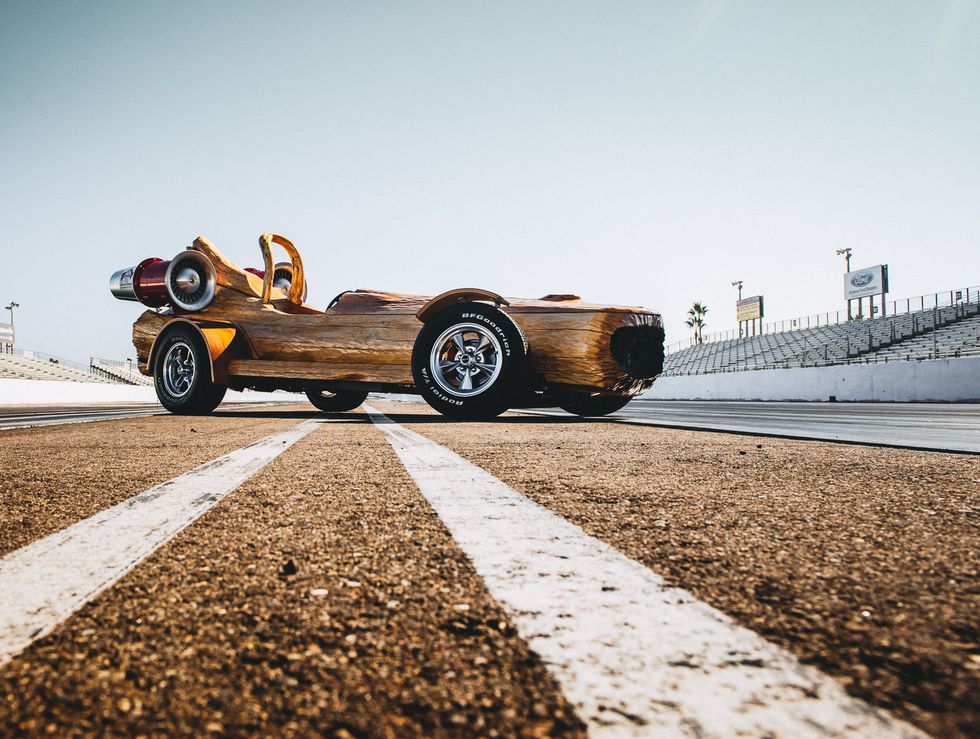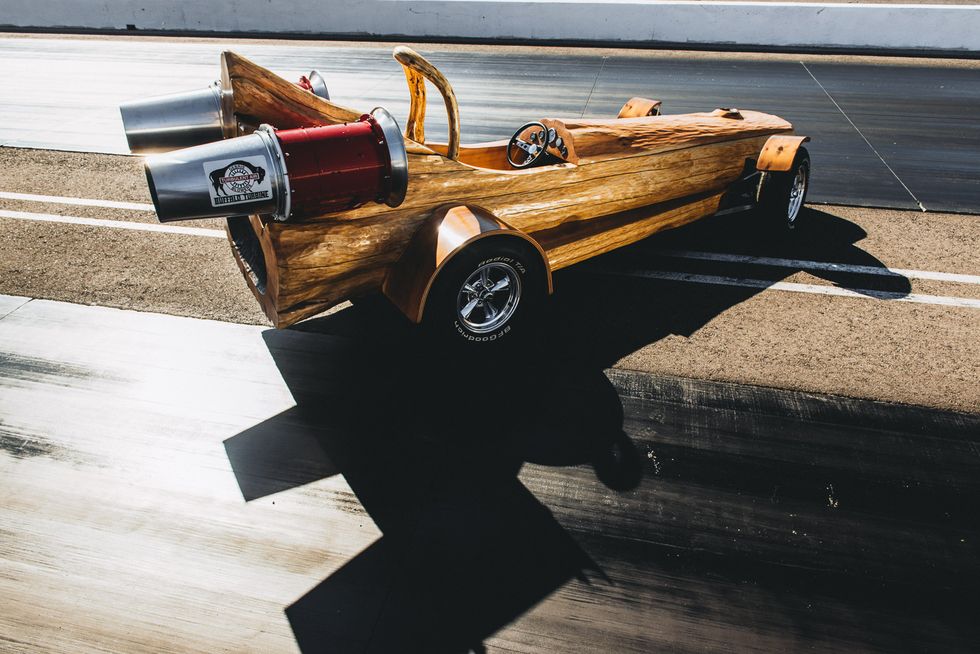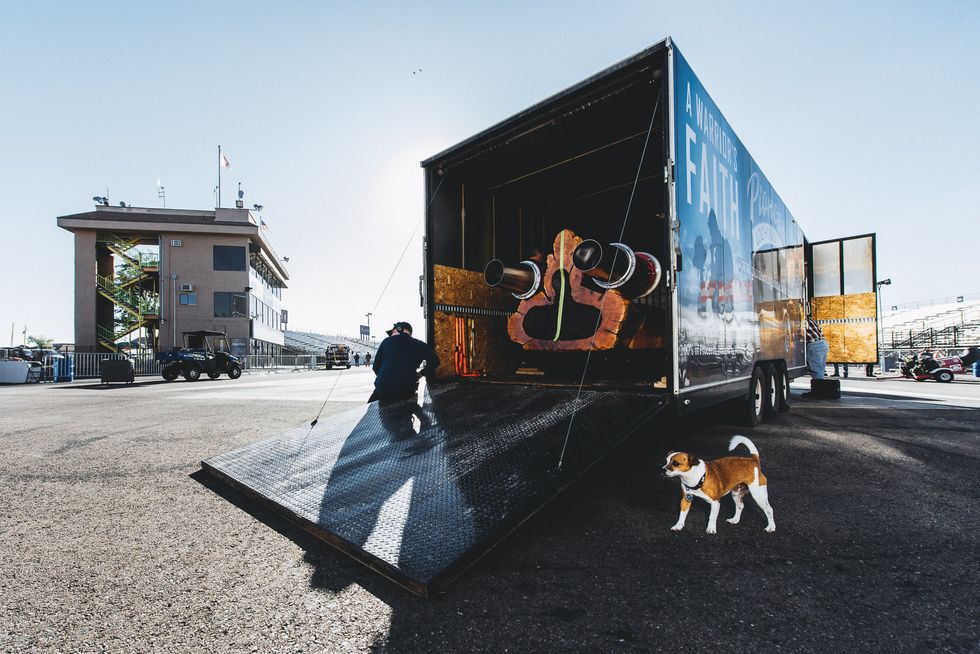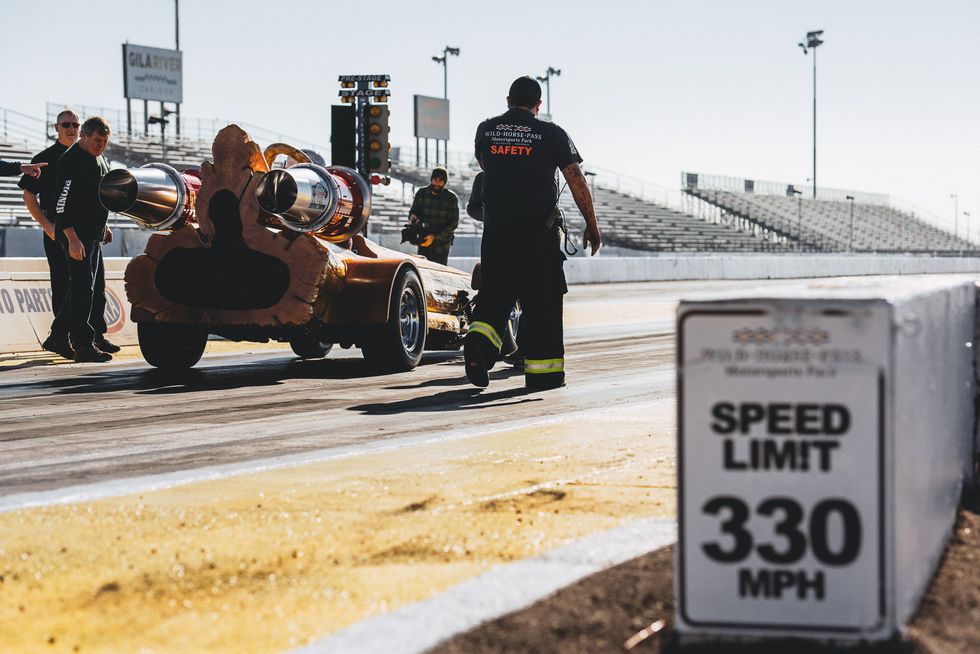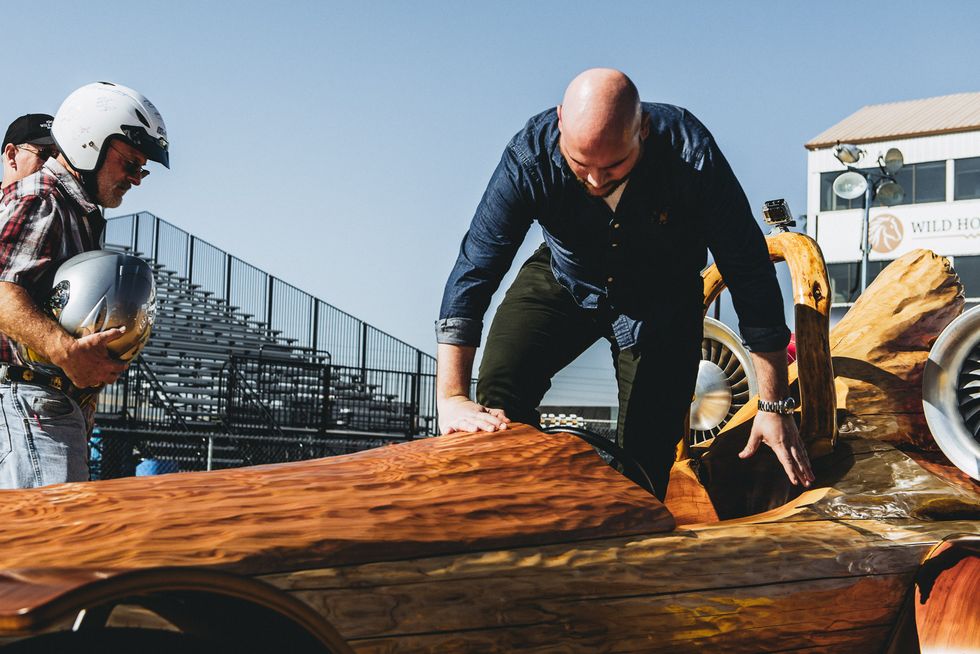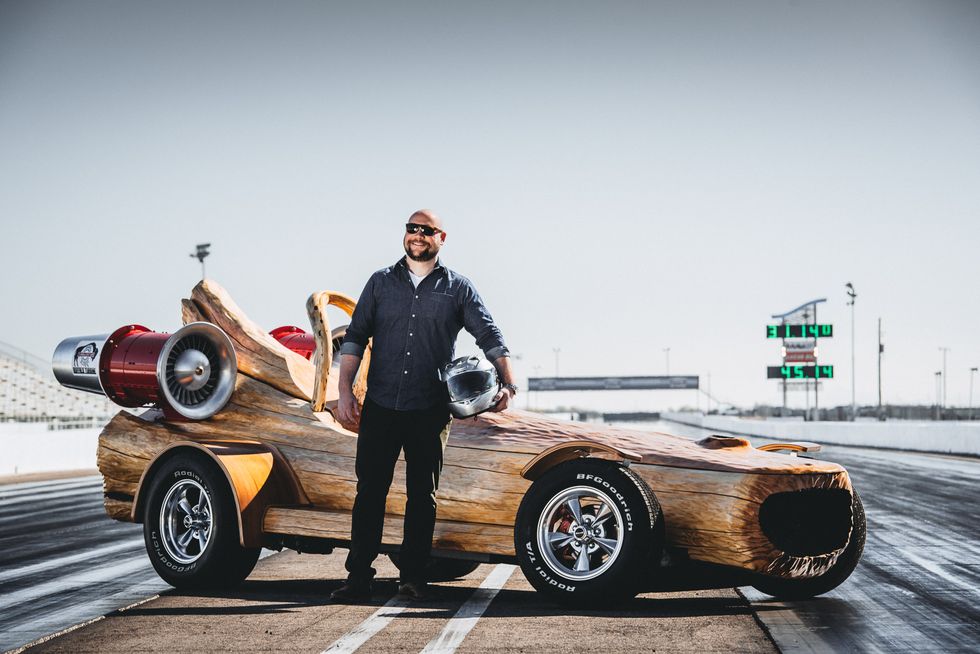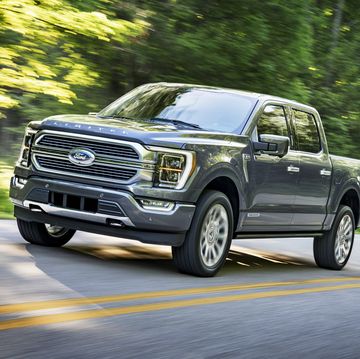THE FIRST TIME YOU SEE IT, your brain almost short circuits—nope, uh-uh, that's not real. But it is, and it is exactly what it looks like: a tree car. More specifically, it is a car made out of a western red cedar log with a concave mouth for a "grille", a wooden roll bar and wooden fenders, and a pair of turbines protruding from its rear. The thing looks ludicrous, like something a crazed Woody the Woodpecker would drive, or maybe a George Barris creation if he had ever gotten lost in the Pacific Northwest with an axe and a flask of whiskey.
It gets better: The log car is rear-wheel drive, uses the mechanicals from a Mazda RX-7, and is powered by eight lithium-ion batteries. More than 500 pounds of them.
Why? Why would someone do this, you might ask. And who? Who in the world would devote time to such a project? Also, what? What were they smoking? Must've been some potent stuff.
Called the Cedar Rocket, the log car is the creation of Bryan Reid Sr. and friends. Reid is the founder of Pioneer Log Homes in Williams Lake, British Columbia, and more recently, the star of the quasi-reality HGTV Canada show Timber Kings, which follows Reid and his Pioneer crew on their builds and adventures. Once you meet Reid, it's easy to see his appeal to a producer. Sturdily built, he's an affable fellow with a trimmed gray beard and a rustic Canadian accent that makes him seem as down to earth as the trees he harvests.
As Reid tells it, he's had the idea for a log car for some time, but the plans for the Cedar Rocket really started to come together two years ago at the Barrett-Jackson auto auction in Scottsdale, Arizona. Figuring the same person that can afford a million-dollar car might also be in the market for a million-dollar log home, Pioneer regularly has a presence at Barrett. At the show, Reid started talking about making a car with Gerald Overton, his high school friend and a mechanic. A Pioneer homeowner who owns Buffalo Turbines based in New York was also present.
"We're standing there, the three of us—there's a turbine manufacturer, a mechanic, and a log builder," Reid says. "Gerald started doing a little sketch, and pretty soon he had a fun-shaped log with tires and wheels. And then he sketches turbines on it. Gerald's doing this diddly-doodlin', and all of the sudden the idea comes."
Now, before we go any further, let me address what everyone is wondering: No, those large red-and-silver turbines flanking the car's rear do not power the car in any way. They are mostly for show. Connected to electric motors, they work, but spinning and whirring is about all they do. So why include them? Well, why not? They certainly make the car look even more ridiculous, and drawing attention is the whole point of the Cedar Rocket. For Reid, the end goal is to sell the car at next year's Barrett-Jackson auction and have all the proceeds go to American war veterans.
Before selling the car, though, Reid plans to take the Cedar Rocket to various events all over the U.S. To kick off this year-long tour, Reid contacted Guinness World Records about possibly driving the car for a world record before displaying it at the 2016 Barrett-Jackson auction. That's how I ended up at the Wild Horse Pass Motorsports Park in Chandler, Arizona, three weeks ago on a bright and clear morning. Reid was going to attempt to set the record for the world's fastest motorized log car for an episode of Timber Kings, and his team invited me down to watch the run and drive the Cedar Rocket myself. It took some convincing, but I finally agreed. Kidding. It's a tree on wheels. Of course I immediately said yes.
As far as anyone knows, no one has ever made a working car out of a log before—much less tried to set a world record with one. This meant that Guinness's ruling body had to come up with a goal speed for Reid to hit. Otherwise, just rolling 20 feet at five mph would count as a record. The goal speed had to strike a balance between being feasible while also being at least a bit challenging. In the end, Guinness decided that Reid would have to hit 50 kph, or 31 mph, twice within an hour.
Now, that doesn't sound like much until you remember that we're talking about a rolling piece of timber assembled as a side project mainly for publicity. In the weeks leading up to my Phoenix trip, the possibility of a gruesome death by a thousand splinters had become a very real and nagging prospect in the back of my mind. I was going to wear a helmet, but that wasn't going to do much for me if something went really wrong. I remained optimistic mostly on blind faith.
Until Arizona, all I'd seen of the Cedar Rocket were some photos and a short clip of it rolling through Reid's backyard. So when the Timber Kings crew backed the car out of its trailer and I got my first look at it in the grain, I was relieved. Not only did it work, but the car looked shockingly legitimate! I'm not saying it would win Le Mans or could even handle a tight roundabout at speed, but it at least looked solid enough to make it down a quarter-mile straight without rolling off the frame and flattening the driver like a lump of cookie dough. Or so I hoped.
The log, which Reid had lopped the underside off of to create an even surface, is attached to a simple step frame. Overton, who served as the project's engineer, says he used a similar one while restoring his own Model A coupe, and it seemed like the perfect fit for the tree's shape. "I decided that would be a really great starting point for the log car, just to set something on," he says. "We needed something that was quick and easy."
The team knew it wanted an independent suspension and disc brakes, and it eventually settled on using the setup from a Mazda RX-7. With some modifications, it would work well with the step frame, and because the Cedar Rocket didn't need shocks with a lot of travel, the RX-7's coilovers seemed like a good fit.
"We would have liked to have gotten some air coilovers that could have been more adjustable, because we didn't know what the weight of the log was going to be," Overton says. But that didn't end up being an issue. In total, the Cedar Rocket weighs roughly 2200 pounds, and the log has already lost some weight from when it was put on the frame a bit green. Overton estimates that it has another 10 percent of its water weight left to shed.
Almost 550 pounds of the car's total weight comes from the eight lithium-ion batteries stored in the nose of the log, which, yes, has an operating hood. To open it, just remove the bolt hidden in the nose's knot. The battery box and instrument gauges were installed by Canadian Electric Vehicles, who makes luggage tugs for airports, among other products. "They're basically using the same type of drive system, so we adapted that to the differential in there," Overton says.
All together, the batteries are good for 96 amp hours and connected to a 35-horsepower electric motor located under the driver's seat. The motor is then attached to the RX-7 differential, which Overton says matches up well with the electric motor since it has a lower gear ratio.
Steering is unassisted, but Overton included a power assist just in case the car was too heavy to handle. "I didn't expect it to be very driver friendly," he says. "I knew it was going to be a nightmare to try and get something like that to even be manageable."
As for why they chose to make the car electric, Reid says the team considered several different engines, but an electric drivetrain was more manageable and also more representative of the times. "People are trying to conserve, people are trying to be mindful of the environment," he says. "So it didn't take long for us to decide we were going fully electric."
The irony of using a battery-powered dead tree to promote conservation aside, choosing the right log was important. Pioneer keeps thousands of logs in stock at its curing site in Williams Lake, but Reid wanted a uniform shape. After several walk-throughs and rounds of winnowing, Reid and Overton kept coming back to the same log. "It reminded us of a rocket ship, the fins on a rocket ship," Reid says. According to Reid, the rings on the tree indicate it was 240 years old. I didn't count to verify, but I can attest that there were a lot of rings. Maybe even 240 of them.
While Overton worked on the frame, Reid and his Pioneer team did all of the woodwork by hand using chainsaws and chisels. "There are literally thousands of hours in that car," Reid says. "Every stroke you see in that car is hand-chiseled."
That includes the wooden hubcaps. Did I mention there's a set of wooden hubcaps?
It was late morning by the time the man from Guinness arrived in his official logo-emblazoned jacket that had a shiny blue lining to match his shiny blue tie. The Cedar Rocket was positioned on the freshly prepped drag strip and ready for some record breaking. My bald head was starting to burn from the blazing Arizona sun.
After clarifying the rules with the Guinness representative and some antics from the Timber Kings cast for the show, Reid took his first crack at hitting the 31 miles per hour needed to set the record. Amidst shouts and cheers, silently and slowly he took off, the Cedar Rocket gaining momentum more like a train than a torquey electric car. At top speed, Reid managed an impressive 45.1 mph on his first run. More than enough for the record. Now he just had to do it again.
Most importantly, the car made it down the track without any major issues. However, there was some cause for concern: During acceleration, the chassis had more flex than a trampoline. For a moment, I thought the Cedar Rocket might just bounce itself apart. But it didn't, and on his second run, now more confident, Reid managed to hit 49.87 mph, setting the record and securing himself a place in the annals of motorized log history.
Once the official from Guinness presented Reid with his certificate, it was my turn to hop behind the wheel. Stepping carefully into the cockpit so as not to scuff the Cedar Rocket's glossy finish, I slowly slid my feet into the nose of the car. The cockpit is snug, and the driver sits quite high, poking out of the log's hole like a prairie dog on high alert.The dash controls are simple: a big red button turns the car on when pulled out, a toggle switches the car between forward and reverse, and another switch controls the turbines. Accelerator. Brake. That's it.
With the turbines spinning—they at least add a bit of a soundtrack—I buried my foot into the throttle. Nothing. Then, after a brief delay, the car lurched forward. It's not hard to figure out why the pause: The vehicle weighs more than a ton and uses a golf cart-size motor to turn relatively large wheels and move all that mass. Despite its name, rocketing off the line is not what the Cedar Rocket does.
Once rolling, the first thing you notice is the steering. It's heavy, and the extra effort takes a second to get used to. This doesn't matter all that much, of course, because the car wasn't made to be a nimble racer. And while it felt solidly assembled, the chorus of squeaks and groans that came from the suspension as the car jounced down the drag strip was a reminder of the vehicle's limits. It likes to go straight. It wants to go straight. Let it go straight.
I also experienced the same trampoline effect as Reid, and I think it was a result of some combination of the track surface, the flexibility of the frame and log, and the Cedar Rocket's overall weight. Up through about 35 mph, the car felt like it was driving through turbulence. But keep going, and on the other side is smooth cruising. When the car did finally settle down, I found myself gliding along, wind in my face, as if I were in a cave man's Caterham.
We didn't clock my first run, but on my second, we lit up the drag strip's Christmas tree and went for it. Unfortunately, I think my first run was faster. With the car being so heavy and the motor overmatched, the tiniest details matter. The longer and straighter the car goes, the faster it gets. The slightest steering correction eats up energy, and lifting off the throttle might as well be like tapping the brakes. That's where I think I faulted. Between the car's worrisome bucking and getting prepared for the vehicle turnaround at the end of the strip, I might have lifted off the pedal early. Or maybe I just weigh more than Reid. Either way, I only hit 42 mph.
But! But my run was not a complete failure. Technically, I am still the second-fastest man to ever drive a motorized log, and that's something. Maybe it's not my name in the Guinness Book of World Records, but it's enough for a good story when I end up having a few too many pints of Guinness at the bar. I might as well brag while I can, because who knows how long my unofficial title—or the official record, for that matter—will remain.
Unless someone gets really industrious and motivated, whoever does buy the Cedar Rocket will probably have the best shot at breaking the record. And when you think about it, that's a pretty easy way for a person to get their own Guinness record. With the proceeds going to charity, the expense of the vehicle can be written off. You just have to be able to afford the sale price up front, which Reid hopes to be $1 million or more. As crazy as that sounds for a tree on wheels, someone will probably go for it.
And to that wealthy person, all I ask is this: If you do try to break the record, please invite me. I promise I'll gladly come in second.

